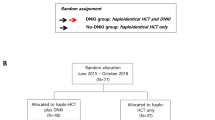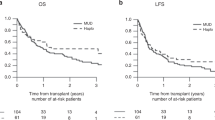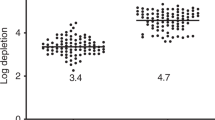Summary:
We have performed a prospective study to evaluate early chimerism and its kinetics after allogeneic peripheral blood stem cell transplantation among 68 patients who received a reduced-intensity conditioning (RIC) regimen with fludarabine plus melphalan (n=40) or busulphan (n=28). Chimerism was analyzed by polymerase chain reaction amplification of short tandem repeats in unfractionated (UF) and/or fractionated nucleated cells from bone marrow and peripheral blood (PB). All of the patients showed initial donor engraftment and no patient presented primary or secondary graft failure. In UF samples, the probability of achieving stable complete donor chimerism (CDC) in PB within the first 6 months was 70% on day +30, 85% on day +100 and 95% on day +180. CDC in granulocytes was observed in nearly all cases from day +30 onwards. CDC in T cells, however, differed among melphalan and busulphan recipients during the first 3 months (100 vs 0% on day +30 and 93 vs 20% on day +90, respectively). In multivariate analysis, the only significant variable associated with the achievement of early CDC was having received more than two lines of chemotherapy pretransplant (P<0.02). No correlation was found between the rate of achieving early CDC and the occurrence of acute graft-versus-host disease (GVHD) or disease progression post-transplant. In multivariate analysis, the only variable that influenced the incidence of disease progression post-transplant was the development of chronic extensive GVHD (P<0.05). In conclusion, a state of CDC is readily obtained within the first 6 months after our RIC protocols. Donor myeloid engraftment occurs rapidly in all cases, while early T-cell CDC is more common in more immunosuppressed hosts and, perhaps, in melphalan recipients.
This is a preview of subscription content, access via your institution
Access options
Subscribe to this journal
Receive 12 print issues and online access
$259.00 per year
only $21.58 per issue
Buy this article
- Purchase on Springer Link
- Instant access to full article PDF
Prices may be subject to local taxes which are calculated during checkout


Similar content being viewed by others
References
Giralt S, Estey E, Albitar M et al. Engraftment of allogeneic hematopoietic progenitor cells with purine analog-containing chemotherapy. Harnessing graft-versus-leukemia without myeloablative therapy. Blood 1997; 89: 4531–4536.
Khouri IF, Keating M, Korbling M et al. Transplant-lite: induction of graft-versus-malignancy using fludarabine-based nonablative chemotherapy and allogeneic blood progenitor-cell transplantation as treatment for lymphoid malignancies. J Clin Oncol 1998; 16: 2817–2824.
Slavin S, Nagler A, Naparstek E et al. Nonmyeloablative stem cell transplantation and cell therapy as an alternative to conventional bone marrow transplantation with lethal cytoreduction for the treatment of malignant and nonmalignant hematological diseases. Blood 1998; 91: 756–763.
Childs R, Clave E, Contentin N et al. Engraftment kinetics after nonmyeloablative allogeneic peripheral blood stem cell transplantation: full donor T-cell chimerism precedes alloimmune responses. Blood 1999; 94: 3234–3241.
Carella AM, Champlin R, Slavin S et al. Mini-allografts: ongoing trials in humans (editorial). Bone Marrow Transplant 2000; 25: 345–350.
Carella AM, Giralt S, Slavin S . Low intensity regimens with allogeneic hematopoietic stem cell transplantation as treatment of hematologic neoplasia. Haematologica 2000; 85: 304–313.
Martino R, Caballero MD, Canals C et al for the alloPBSCT subcommittee of the Spanish Group for Hematopoietic Transplantation (GETH) and theGroup GEL-TAMO. Allogeneic peripheral blood stem cell transplantation with reduced-intensity conditioning: results of a prospective multicenter study. Br J Haematol 2001; 115: 653–659.
Ferrara JLM, Deeg HJ . Graft-versus-host disease. N Engl J Med 1991; 324: 667–674.
McSweeney PA, Niederwieser D, Shizuru JA et al. Hematopoietic cell transplantation in older patients with hematologic malignancies: replacing high-dose cytotoxic therapy with graft-versus-tumor effects. Blood 2001; 97: 3390–3400.
Giralt S, Thall PF, Khouri I et al. Melphalan and purine analog-containing preparative regimens: reduced-intensity conditioning for patients with hematologic malignancies undergoing allogeneic progenitor cell transplantation. Blood 2001; 97: 631–637.
Mattsson J, Uzunel M, Brune M et al. Mixed chimerism is common at the time of acute graft-versus-host disease response in patients receiving non-myeloablative conditioning and allogeneic stem cell transplantation. Br J Haematol 2001; 115: 935–944.
Kottaridis PD, Milligan DW, Chopra R et al. In vivo CAMPATH-1H prevents graft-versus-host disease following nonmyeloablative stem cell transplantation. Blood 2000; 96: 2419–2425.
Antin JH, Childs R, Filipovich AH et al. Establishment of complete and mixed donor chimerism after allogeneic lymphohematopoietic transplantation: recommendations from a workshop at the 2001 tandem meetings. Biol Blood Marrow Transplant 2001; 7: 473–485.
Mattsson J, Uzunel M, Remberger M et al. T-cell mixed chimerism is significantly correlated to a decreased risk of acute graft-versus-host disease after allogeneic stem cell transplantation. Transplantation 2001; 71: 433–439.
Gyger M, Baron C, Forest L et al. Quantitative assessment of hematopoietic chimerism after allogeneic bone marrow transplantation has predictive value for the occurrence of irreversible graft failure and graft-vs-host disease. Exp Hematol 1998; 26: 426–434.
Molina A, McSweeney P, Maloney DG et al. Degree of early donor T-cell chimerism predicts GVHD and graft rejection in patients with nonmyeloablative hematopoietic stem cell allografts. Blood 1999; 94: 394a.
Horowitz MM, Gale RP, Sondel PM et al. Graft-versus-leukemia reactions after bone marrow transplantation. Blood 1990; 75: 555–562.
Weiden PL, Flournoy N, Thomas ED et al. Antileukemic effect of graft- versus-host disease in human recipients of allogeneic-marrow grafts. N Engl J Med 1979; 300: 1068–1073.
Champlin RE, Schmitz N, Horowitz MM et al. Blood stem cells compared with bone marrow transplantation as a source of hematopoietic cells for allogeneic transplantation. Blood 2000; 95, 3702–3709.
Author information
Authors and Affiliations
Rights and permissions
About this article
Cite this article
Valcárcel, D., Martino, R., Caballero, D. et al. Chimerism analysis following allogeneic peripheral blood stem cell transplantation with reduced-intensity conditioning. Bone Marrow Transplant 31, 387–392 (2003). https://doi.org/10.1038/sj.bmt.1703846
Received:
Accepted:
Published:
Issue Date:
DOI: https://doi.org/10.1038/sj.bmt.1703846
Keywords
This article is cited by
-
Assessing the efficacy of an ambulatory peripheral blood hematopoietic stem cell transplant program using reduced intensity conditioning in a low-middle-income country
Bone Marrow Transplantation (2019)
-
Comparison of reduced intensity conditioning regimens used in patients undergoing hematopoietic stem cell transplantation for myelofibrosis
Bone Marrow Transplantation (2019)
-
Single-agent GvHD prophylaxis with tacrolimus after post-transplant high-dose cyclophosphamide is a valid option for haploidentical transplantation in adults with hematological malignancies
Bone Marrow Transplantation (2017)
-
Preferential depletion of host over donor T cells through in vivo decay of active rabbit-anti-thymocyte globulin levels during reduced intensity conditioning
Bone Marrow Transplantation (2015)
-
Kinetics of peripheral blood chimerism for surveillance of patients with leukemia and chronic myeloid malignancies after reduced-intensity conditioning allogeneic hematopoietic SCT
Bone Marrow Transplantation (2015)



